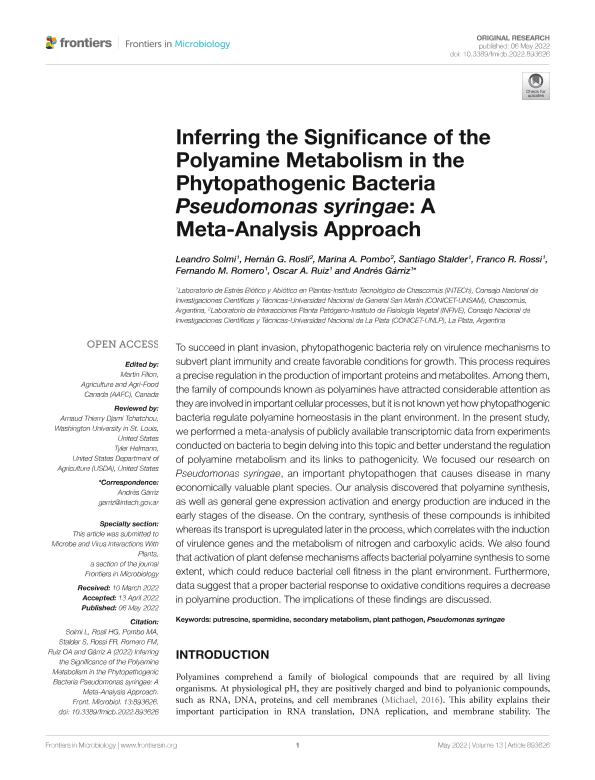Mostrar el registro sencillo del ítem
dc.contributor.author
Solmi, Leandro

dc.contributor.author
Rosli, Hernan Guillermo

dc.contributor.author
Pombo, Marina Alejandra

dc.contributor.author
Stalder, Santiago
dc.contributor.author
Rossi, Franco Rubén

dc.contributor.author
Romero, Fernando Matias

dc.contributor.author
Ruiz, Oscar Adolfo

dc.contributor.author
Gárriz, Andrés

dc.date.available
2023-02-16T13:03:08Z
dc.date.issued
2022-05
dc.identifier.citation
Solmi, Leandro; Rosli, Hernan Guillermo; Pombo, Marina Alejandra; Stalder, Santiago; Rossi, Franco Rubén; et al.; Inferring the Significance of the Polyamine Metabolism in the Phytopathogenic Bacteria Pseudomonas syringae: A Meta-Analysis Approach; Frontiers Media; Frontiers in Microbiology; 13; 5-2022; 1-14
dc.identifier.issn
1664-302X
dc.identifier.uri
http://hdl.handle.net/11336/188246
dc.description.abstract
To succeed in plant invasion, phytopathogenic bacteria rely on virulence mechanisms to subvert plant immunity and create favorable conditions for growth. This process requires a precise regulation in the production of important proteins and metabolites. Among them, the family of compounds known as polyamines have attracted considerable attention as they are involved in important cellular processes, but it is not known yet how phytopathogenic bacteria regulate polyamine homeostasis in the plant environment. In the present study, we performed a meta-analysis of publicly available transcriptomic data from experiments conducted on bacteria to begin delving into this topic and better understand the regulation of polyamine metabolism and its links to pathogenicity. We focused our research on Pseudomonas syringae, an important phytopathogen that causes disease in many economically valuable plant species. Our analysis discovered that polyamine synthesis, as well as general gene expression activation and energy production are induced in the early stages of the disease. On the contrary, synthesis of these compounds is inhibited whereas its transport is upregulated later in the process, which correlates with the induction of virulence genes and the metabolism of nitrogen and carboxylic acids. We also found that activation of plant defense mechanisms affects bacterial polyamine synthesis to some extent, which could reduce bacterial cell fitness in the plant environment. Furthermore, data suggest that a proper bacterial response to oxidative conditions requires a decrease in polyamine production. The implications of these findings are discussed.
dc.format
application/pdf
dc.language.iso
eng
dc.publisher
Frontiers Media

dc.rights
info:eu-repo/semantics/openAccess
dc.rights.uri
https://creativecommons.org/licenses/by/2.5/ar/
dc.subject
PLANT PATHOGEN
dc.subject
PSEUDOMONAS SYRINGAE
dc.subject
PUTRESCINE
dc.subject
SECONDARY METABOLISM
dc.subject
SPERMIDINE
dc.subject.classification
Biología Celular, Microbiología

dc.subject.classification
Ciencias Biológicas

dc.subject.classification
CIENCIAS NATURALES Y EXACTAS

dc.title
Inferring the Significance of the Polyamine Metabolism in the Phytopathogenic Bacteria Pseudomonas syringae: A Meta-Analysis Approach
dc.type
info:eu-repo/semantics/article
dc.type
info:ar-repo/semantics/artículo
dc.type
info:eu-repo/semantics/publishedVersion
dc.date.updated
2023-02-09T15:31:35Z
dc.journal.volume
13
dc.journal.pagination
1-14
dc.journal.pais
Suiza

dc.journal.ciudad
Lausana
dc.description.fil
Fil: Solmi, Leandro. Universidad Nacional de San Martin. Instituto Tecnologico de Chascomus. - Consejo Nacional de Investigaciones Cientificas y Tecnicas. Centro Cientifico Tecnologico Conicet - la Plata. Instituto Tecnologico de Chascomus.; Argentina
dc.description.fil
Fil: Rosli, Hernan Guillermo. Consejo Nacional de Investigaciones Científicas y Técnicas. Centro Científico Tecnológico Conicet - La Plata. Instituto de Fisiología Vegetal. Universidad Nacional de La Plata. Facultad de Ciencias Naturales y Museo. Instituto de Fisiología Vegetal; Argentina
dc.description.fil
Fil: Pombo, Marina Alejandra. Consejo Nacional de Investigaciones Científicas y Técnicas. Centro Científico Tecnológico Conicet - La Plata. Instituto de Fisiología Vegetal. Universidad Nacional de La Plata. Facultad de Ciencias Naturales y Museo. Instituto de Fisiología Vegetal; Argentina
dc.description.fil
Fil: Stalder, Santiago. Universidad Nacional de San Martin. Instituto Tecnologico de Chascomus. - Consejo Nacional de Investigaciones Cientificas y Tecnicas. Centro Cientifico Tecnologico Conicet - la Plata. Instituto Tecnologico de Chascomus.; Argentina
dc.description.fil
Fil: Rossi, Franco Rubén. Universidad Nacional de San Martin. Instituto Tecnologico de Chascomus. - Consejo Nacional de Investigaciones Cientificas y Tecnicas. Centro Cientifico Tecnologico Conicet - la Plata. Instituto Tecnologico de Chascomus.; Argentina
dc.description.fil
Fil: Romero, Fernando Matias. Universidad Nacional de San Martin. Instituto Tecnologico de Chascomus. - Consejo Nacional de Investigaciones Cientificas y Tecnicas. Centro Cientifico Tecnologico Conicet - la Plata. Instituto Tecnologico de Chascomus.; Argentina
dc.description.fil
Fil: Ruiz, Oscar Adolfo. Universidad Nacional de San Martin. Instituto Tecnologico de Chascomus. - Consejo Nacional de Investigaciones Cientificas y Tecnicas. Centro Cientifico Tecnologico Conicet - la Plata. Instituto Tecnologico de Chascomus.; Argentina
dc.description.fil
Fil: Gárriz, Andrés. Universidad Nacional de San Martin. Instituto Tecnologico de Chascomus. - Consejo Nacional de Investigaciones Cientificas y Tecnicas. Centro Cientifico Tecnologico Conicet - la Plata. Instituto Tecnologico de Chascomus.; Argentina
dc.journal.title
Frontiers in Microbiology
dc.relation.alternativeid
info:eu-repo/semantics/altIdentifier/url/https://www.frontiersin.org/articles/10.3389/fmicb.2022.893626/full
dc.relation.alternativeid
info:eu-repo/semantics/altIdentifier/doi/http://dx.doi.org/10.3389/fmicb.2022.893626
Archivos asociados
